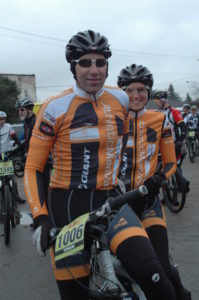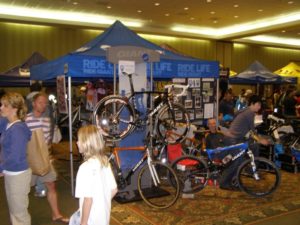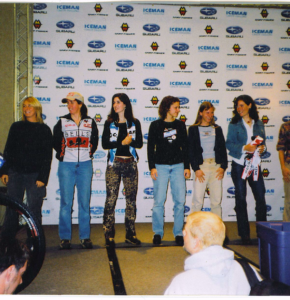 By: Terry Ritter
By: Terry Ritter
Somewhere along the way I became an elder statesmen in the racing scene. Though I can’t pinpoint when this exactly was, I know it’s happened every season when the Iceman rolls around. There’s a chat with a new or novice racer and I reminisce regarding all the changes I remember over the years in the great November race. Though I’m sure others (though not many) can tell me some interesting changes, my quarter century of Iceman participation leaves me with a few things many people who identify with this event probably don’t know.
There Used to Be a More Traditional Race Format
For a number of years Iceman was organized like most traditional races. There were ubiquitous categories like Beginner, Sport, and Expert, with age groups aligning with the age groupings based off the long defunct NORBA standard. This meant each of these categories had five year age divisions up to and over 50 years old. It made for smaller fields, but you also knew who you were racing against when the gun went off, which was the norm. It was certainly a different way to race head-to-head versus today’s individual time trial method, where your time is then compared to others regardless of your starting wave. Obviously, you could almost pick what class you wanted, and that did group riders of dissimilar abilities, Today’s waving placement method, though frustrating for some, works more effectively to eliminate this disparity.
The Pro’s Started the Race First
It’s probably been well over a dozen years, but the race was more traditional in other ways as well. Primarily, the Pro fields, both men’s and women’s, started in their own waves, but were the first to go off. This created a lot more buzz at the start, and also insured they had the “clean” lines. But it was recognized that many  of the Iceman racers were also fans, and they never got a chance to see the pros race, and specifically to finish. The solution was to have the pros go off in the afternoon, after most of the fields had finished and had time to clean up and get a little into their celebratory mode. I was racing the Pro class when we first did the later start. Having done only morning send offs to that point, it was really strange to stand there trying to amp up to compete and there was hardly anyone in the parking lot, and next to no buzz at the start. I distinctly remember being able to hear others around me breathing it was so quiet just seconds before the start. And though I went through a lot of that race competing with just a handful of riders, it was really cool to get closer to the finish and see all the people, then to get to Timber Ridge and have so many cheering. That made it worth it!
of the Iceman racers were also fans, and they never got a chance to see the pros race, and specifically to finish. The solution was to have the pros go off in the afternoon, after most of the fields had finished and had time to clean up and get a little into their celebratory mode. I was racing the Pro class when we first did the later start. Having done only morning send offs to that point, it was really strange to stand there trying to amp up to compete and there was hardly anyone in the parking lot, and next to no buzz at the start. I distinctly remember being able to hear others around me breathing it was so quiet just seconds before the start. And though I went through a lot of that race competing with just a handful of riders, it was really cool to get closer to the finish and see all the people, then to get to Timber Ridge and have so many cheering. That made it worth it!
The Start and Finish Have Changed Over the Years
Back when the Iceman was a fledgling event the finish was at Holiday Hills ski resort, home of the start and finish of the now popular Mud Sweat and Beers MTB race. Since I started race this event in 1996, the start has been at the Kalkaska High School, downtown Kalkaska, and soon to be the Kalkaska Airport (this year). I can remember my first finish in 1996 being out in a field off the VASA Bunker Hill trailhead. No festivities, banners, or food trucks (or bathrooms, even). Before long the race established Timber Ridge Camp Ground as the finish line and it has grown to be a cool hang out as the years have passed.
Awards Banquette
 For a number of years the race had an awards banquette in the evening, usually at the Grand Traverse Resort. With most of the racers finished by noon-2 PM, there was a good 4-5 hours before the awards were to be given out. This allowed a nap, something to eat, and hooking up with friends before heading over to the festivities. I had fond memories of one of my friends who worked for the promoter and lived locally doing an early afternoon spread where a number of the invited pros would come to hang out, eat, and maybe start the beer drinking early. It was a small setting, and people got to talk to each other. For a span of a few years the Iceman was sponsored by Gary Fisher and they used to send a large amount of their national MTB team to the race. I have a neat photo of myself and a young Ryder Hesjedal, many years before he switched to road and won the Giro d’italia.
For a number of years the race had an awards banquette in the evening, usually at the Grand Traverse Resort. With most of the racers finished by noon-2 PM, there was a good 4-5 hours before the awards were to be given out. This allowed a nap, something to eat, and hooking up with friends before heading over to the festivities. I had fond memories of one of my friends who worked for the promoter and lived locally doing an early afternoon spread where a number of the invited pros would come to hang out, eat, and maybe start the beer drinking early. It was a small setting, and people got to talk to each other. For a span of a few years the Iceman was sponsored by Gary Fisher and they used to send a large amount of their national MTB team to the race. I have a neat photo of myself and a young Ryder Hesjedal, many years before he switched to road and won the Giro d’italia.
National Pros Competing
One of the cool things about the Iceman, and cycling in general, is how approachable the top competitors are around the event. The expo the day before wasn’t always what it is today, but often you’d be able to talk to a few of the racers you just see in magazines. But the fact is, though we enjoy a pretty solid pro field in recent years, the Iceman was usually a locals or regional event. One or two good riders would show up that made a living racing a bike, but it wasn’t unheard of for someone you know to break the top 10 in the men’s class or top 5 in the women. Some years the winner would not have been recognized outside of the state. For one of the years Ryder came (and the pros started first in the morning) I remember passing him and another pro about 7 miles from the finish. They were just out enjoying the ride after a long season. To the benefit of the spectators, this hasn’t been the case for a while. Now you are sure to recognize most of the top riders as national competitors, some who have come to compete a few times. And, they know they have to take it seriously because there’s quality riders behind them. Good payouts, great accommodations, the lure of competing in a race they have heard about for years is likely strong drivers to toe the line.
A bonus tidbit, but the Iceman has had a number of world champions compete over the years. Cecila Potts won the 1997 Junior World Championships in MTB and holds four winner’s trophies from Iceman. Art Flemming won multiple national championships for his age group and is the 1996 world champion for the 50-59 year old class. A few years back the great Ned Overend, 6 time national champion and 1990 world champion did his first Iceman. TC local Larry Warbasse, long before he was a national road champion and Pro Tour rider, competed in numerous events. Local John Mesco was a junior national champion in downhill. The present men’s 2x Iceman Cometh champion Jeff Kabush holds 15 Canadian national championships and a World Cup win. Alison Dunlop, the 2009 Iceman winner, was also multi-national champion and world champion in 2001. The late Steve Tilford raced for years as a national pro and won a number of age group world championships. Jeremy Horgan-Kobelski and his wife Heather Irmiger have both won national championships and competed and won our great race. I’m missing a few, and haven’t even mentioned the interesting racers many would recognize (Gary Fisher, anyone?), but the point is the race has had its share of accomplished participants in all fields cycling.
The Iceman Cometh has really evolved over the years, from a small group of friends to a spectacle that people put on their cycling bucket list. Along the way it has found a way to become better while still holding that same spirit of fun that is mountain biking and racing. I consider myself fortunate to have witnessed so much of it and am still around to share. Happy Birthday, Iceman! Here’s to 30 more years.
The post Iceman Reflux appeared first on Team Athletic Mentors.

 Athletic Mentors
Athletic Mentors